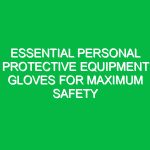Introduction
In the realm of Health, Safety, and Environment (HSE), personal protective equipment (PPE) includes a range of gear designed to safeguard workers from various Hazards they may encounter in their workplaces. The significance of PPE cannot be overstated; it serves as the last line of defense against injuries, illnesses, and fatalities resulting from workplace Hazards. This article delves into the essential Types of PPE, their applications, and Best Practices for ensuring Safety in various environments.
PPE encompasses items such as helmets, gloves, eye protection, hearing protection, respirators, and protective clothing. Each piece plays a critical role in mitigating risks associated with physical, chemical, biological, and ergonomic hazards. Understanding how to select, use, and maintain PPE is vital for anyone committed to fostering a safe work environment.
Understanding Personal Protective Equipment (PPE) Includes
Personal protective equipment includes a broad spectrum of tools and clothing designed to protect employees from specific dangers. The selection of appropriate PPE depends on the nature of the work being performed and the hazards present. Below, we categorize the types of PPE and their relevance to HSE practices.
1. Head Protection
Hard hats are the quintessential example of head protection. They shield workers from falling objects, bumps, and Electrical Hazards. The Occupational Safety and Health Administration (OSHA) mandates the use of hard hats in environments where such risks exist.
For instance, in construction sites, a hard hat can prevent serious head injuries, as recounted by a construction manager who witnessed a near-miss incident where a tool fell from scaffolding. The worker wearing a hard hat was unharmed, underscoring the importance of this vital piece of PPE.
2. Eye and Face Protection
Safety glasses, goggles, and face shields protect against flying debris, chemical splashes, and intense light. In laboratories and manufacturing settings, eye injuries are prevalent, making proper Eye Protection essential.
Consider a scenario in a chemical plant where an employee inadvertently spills a corrosive substance. If that worker had donned appropriate goggles, the likelihood of severe eye damage would have significantly decreased. Regular Training on the correct use of eye protection can enhance awareness and compliance.
3. Hearing Protection
Noise-induced hearing loss is a common issue in industrial environments. Earplugs and earmuffs help mitigate this risk. osha provides guidelines on permissible noise exposure levels, emphasizing the need for hearing protection in settings that exceed these limits.
A case study from an automotive factory revealed that employees who consistently wore hearing protection reported fewer incidents of hearing impairment. This reinforces the value of integrating PPE into regular Safety protocols.
4. Respiratory Protection
Respirators are crucial in environments where airborne contaminants such as dust, fumes, or infectious agents are present. There are various types of respirators, including N95 masks and full-face respirators, each suited for specific hazards.
During the COVID-19 pandemic, the importance of respiratory protection became glaringly evident. Healthcare workers equipped with N95 masks were better protected against viral exposure, demonstrating the critical role of respiratory PPE in safeguarding health.
5. Hand Protection
Gloves protect against cuts, abrasions, chemical exposure, and thermal hazards. The choice of gloves should align with the specific risks present in the workplace. For instance, in a food processing plant, workers need cut-resistant gloves, while those in chemical manufacturing require chemical-resistant gloves.
A personal anecdote from a nurse illustrates this point: during her clinical rotations, she encountered numerous instances where improper glove use led to cross-contamination. Proper training and selection of gloves not only protect the wearer but also prevent the spread of harmful substances.
6. Foot Protection
Safety footwear, including steel-toed boots, guards against punctures, crushing injuries, and slips. In warehouses and construction sites, the risk of foot injuries is high, making appropriate footwear a necessity.
A warehouse supervisor recounted an incident where a worker dropped a heavy box on his foot. Fortunately, he was wearing steel-toed boots, which prevented serious injury. This highlights the importance of proper footwear in preventing workplace injuries.
7. Body Protection
Protective clothing, including coveralls, aprons, and high-visibility vests, is essential for protection against chemical spills, sharp objects, and visibility hazards. In environments where chemical exposure is a concern, specialized clothing can significantly reduce the risk of skin irritation or Burns.
For example, workers in a metal fabrication shop often wear flame-resistant clothing to guard against sparks and potential burns. An incident involving a flash fire in such a setting could have resulted in severe injuries if not for the use of proper protective clothing.
Best Practices for PPE Use
To ensure the effectiveness of Personal Protective Equipment, organizations must implement Best Practices surrounding its use. Here are several key recommendations:
- Proper Training: Workers should receive comprehensive training on the correct use, maintenance, and limitations of PPE. Regular refresher courses can keep safety at the forefront.
- Regular Inspection: PPE should be inspected regularly for signs of wear and tear. Defective equipment should be replaced immediately to maintain safety Standards.
- Fit Testing: For respiratory protection, fit testing is crucial to ensure that the equipment forms a proper seal. This is especially important for tight-fitting respirators.
- Encourage Usage: Foster a culture where wearing PPE is the norm, not the exception. Management should lead by example and prioritize safety in all operations.
- Accessibility: Ensure that PPE is readily accessible to all workers. If employees have to search for equipment, they may skip it altogether, increasing risk.
Potential Hazards and Risks
Understanding the potential hazards in a workplace is critical for the effective selection of PPE. Common risks include:
- Chemical Exposure: Workers may face exposure to harmful chemicals that necessitate specialized PPE like gloves and respirators.
- Physical Hazards: Falling objects, machinery, and slips can lead to serious injuries, highlighting the need for head and foot protection.
- Biological Hazards: In healthcare settings, exposure to bloodborne pathogens requires the use of gloves, masks, and gowns.
- Ergonomic Risks: While PPE doesn’t directly address ergonomic issues, using proper equipment can help reduce the physical strain on workers.
Regulations and Standards
Compliance with Regulations governing PPE is essential for maintaining safety in the workplace. OSHA sets forth standards that dictate when and how PPE should be used. Employers are legally obligated to assess workplace hazards and provide adequate PPE to their employees.
In addition to OSHA regulations, other standards exist, such as those from the American National Standards Institute (ANSI) and the National Institute for Occupational Safety and Health (NIOSH). These organizations establish guidelines for the design and performance of PPE, ensuring that equipment meets minimum safety criteria.
Ignoring these regulations can lead to severe consequences, including fines, legal action, and tragic accidents. For instance, a manufacturing plant that failed to provide adequate PPE faced a significant lawsuit after a worker sustained severe injuries due to lack of protection.
Conclusion
In conclusion, personal protective equipment includes an array of essential items that collectively work to safeguard workers from various hazards. Understanding the different types of PPE, their applications, and the best practices for their use is crucial for anyone involved in HSE. By prioritizing safety and compliance with regulations, organizations can significantly reduce the risk of workplace injuries and create a safer environment for all employees.
As we reflect on the importance of PPE, it is clear that a proactive approach to health and safety can make a significant difference. Encourage your workplace to invest in proper PPE and the training necessary to ensure that every worker understands its importance. By doing so, we can not only comply with legal standards but also foster a culture of safety that protects lives today and in the future.


